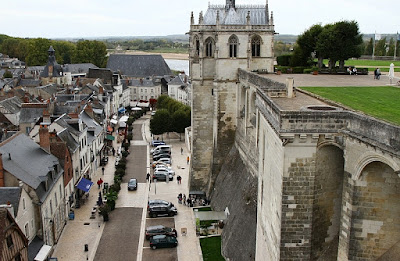St. Malo --> Rennes --> Tours --> Amboise
After Mont St. Michel, our next stop was St. Malo, and our last view of the English Channel. St. Malo still has some of its ancient walls and fortifications.
Some interesting tidbits from the Web...
From 1490–1493, Saint-Malo declared itself to be an independent republic, taking the motto "not French, not Breton, but Malouins".
Saint-Malo became notorious as the home of French privateers ('state-authorized' pirates), forcing English ships passing up the Channel to pay tribute.
Jacques Cartier, credited as the discoverer of Canada, lived in and sailed from Saint-Malo.
An older part of town...
Time to call a roofer... but then I wouldn't have taken this picture if they had.
Let's go get 'em guys.
I couldn't pass the Funky Munky without taking a shot.
Artists at work... art class I'm guessing.
The main square and time for lunch.
On to Rennes Bayeux (Thanks, Patsy) and another cathedral. I've got things screwed up here. I'll sort it out soon. :-)
Imagine anyone even thinking of building a church today like any of the famous cathedrals. Would it not be 'acceptable' today or is it just the money, or both?
The streets of Rennes (not sure now) with typical French architecture.
Leaving
City Hall
There are dozens of caves in the area. They remain from the extraction of 1000s of tons of limestone that were used in the construction of about 300 chateaus, hunting lodges & castles in the Loire Valley by the kings & rich of previous centuries.
We went to a restaurant that was in one of the caves. The walls were the original limestone.
Some of the sights in Tours...
Our tour director posing with a 'gorilla'.
As anywhere, you have a choice of restaurants.
Just another window shot...
The French love flowers & they show it. I wish we did too. They add so much to street views and to the homes & buildings themselves.
They're everywhere!
With our two night stay in Tours, we had time to visit two of the more than 300 chateaux in the Loire Valley. This was one of them-- Chateau d' Amboise in the town of Amboise... home of the French King Louis XI.
The larger round tower to the left was a spiral roadway for carriages from the road below.
Befitting a king, the chateau dominated the town.
King Louis asked Leonardo de Vinci to come to Amboise and paint for him. Hard to refuse a king I suppose, so Leonardo arrived with three of his paintings, one being the Mona Lisa.
This was the mansion (Clos Lucé) that Louis gave to de Vinci. De Vinci died here in 1519... three years after he arrived. It was half a kilometer from the castle, connected by an underground tunnel.
Our local guide here was very knowledgeable but she had the personality of a fence post.
The Gothic chapel where Leonardo is buried... on the grounds of the chateau.
Even the chapel has intricate exterior detail.
This section seemed to be of a bit lower quality but still impressive. Maybe it just didn't weather as well.
My guess from the chateaus/castles I've seen in different countries is that they must have 50+ rooms, lots of marble, tiles where appropriate, fine wood furniture, poster beds, dozens of sculptures & paintings & tapestries, one or two long, spacious hallways and a few spiral staircases. Chateau Amboise was no exception.
This room almost looks too modern, one a commoner could afford even. Maybe the restorers got it wrong. I didn't take many pictures inside.
The town of Amboise taken from the grounds of the chateau.
Homes with character...
To be expected when there's a chateau/castle nearby... try to sell the tourists a suit of armour for a hallway back home. Or maybe a tapestry?
Chateau? Castle? Got me thinking, what's the difference? So of course I Googled it...
from Wikipedia...
===========================================================
A château is a manor house or residence of the lord of the manor or a country house of nobility or gentry, with or without fortifications, originally—and still most frequently—in French-speaking regions. Where clarification is needed, a fortified château (that is, a castle) is called a château fort, such as Château fort de Roquetaillade.
Care should be taken when translating the word château into English. It is not used in the same way as "castle", and most châteaux are described in English as "palaces" or "country houses" rather than "castles". For example, the Château de Versailles is so called because it was located in the countryside when it was built, but it does not bear any resemblance to a castle, so it is usually known in English as the Palace of Versailles.
The urban counterpart of château is palais, which in French is applied only to grand houses in a city. This usage is again different from that of the term "palace" in English, where there is no requirement that a palace must be in a city, but the word is rarely used for buildings other than the grandest royal residences.
===========================================================
Am I any wiser? Sounds confusing to me...
Ain't these cute... and more affordable & easier to pack than a suit of armour.
The Loire River in Amboise.
Another example (in Amboise this time) of a parking lot that blends into the layout of the town.
Chateau #2 coming soon...
- fini -
If you're interested, here's the link for France #5 of 5:
Labels: France






































































